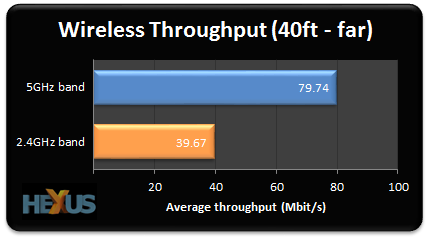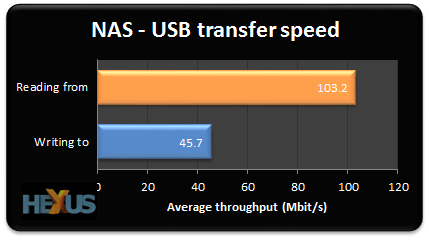Testing results
A router's presentation and control panel don't mean squat if performance is poor, clearly. We tested the N66U's throughput by using the PassMark PerformanceTest benchmark.
Wired performance was evaluated by connecting the router's Gigabit ports to two Intel Core i7 machines using the same Realtek 8111 Gigabit LAN (7.049.0927.2011 driver).
Wireless performance was conducted by using an AMD Llano laptop with a USB-based N53 (2x2) WiFi adapter from ASUS. We tested at two distances that are labelled 'near' and 'far' in the following graphs. The near distance represents performance at five feet, with a direct line-of-sight between router and laptop. Meanwhile, the far graphs denote performance once the laptop is situated 40 feet away, with three (hollow) intervening walls providing signal resistance.
Tests were run five times, with the lowest two discarded and the remaining three averaged. This is our first router review for a while and we present the numbers in isolation, passing general comment along the way. We'll be adding other comparable routers' numbers once they have been tested in the near future.
For full disclosure, we had to manually select a different channel for the 2.4GHz tests. The default channel occupied a crowded space in which several other Wi-Fi networks were present, pushing performance down to a crawl. The performance on the 5GHz band was consistent across all channels, however.
Wired
Attached to two Gigabit-totin' machines, the N66U managed an average throughput of 685.6Mbit/s (85.7MB/s) over the three-minute test period. The number is generally in line with that achieved on a Gigabit switch in previous tests.
Wireless

The ever-escalating speeds of home broadband mean that users need to jump on the 5GHz band to make the most out of super-fast Internet speeds. There's a clear advantage to the higher-frequency band. That said, performance in the 2.4GHz space is competitive against older routers.
We also configured PassMark to run the same test on the 5GHz band with the User Diagram Protocol (UDP) rather than the standard Transmission Control Protocol (TCP). The low-load nature of UDP, which is used in media streaming, online gaming and voip, increased average speed to an impressive, near-double 191.4Mbit/s.

Putting the onus on coverage at a reasonable distance, performance drops by around 15 per cent on the 5GHz band and 30 per cent on the 2.4GHz band. Internet browsing remained snappy and playback of high-definition content (720p, h.264) was stutter-free.
Taking the client laptop as far away from the router while still retaining connectivity, the RT-N66U's range was measured to be approximately 250 feet on both bands.
Network storage

A Corsair Voyager GT 64GB USB 3.0 pendrive was accessed via FTP to copy 2GB of MP3s to a Gigabit-connected (wired) machine. We then wrote the files back to the pendrive, which took just over twice as long. The 103.2Mbit/s reading speed means that playback of high-definition content should be fine, and we had no trouble streaming a 1080p trailer without hiccup.
Power, heat and basic reliability
Running with a Gigabit port and 5GHz wireless working concurrently and at full chat, the N66U pulls 11W from the mains, which, again, is similar to previously-tested routers. The unit does become quite warm to the touch after prolonged use, backed up by an infrared thermometer reading of 47°C for the mock carbon surface of the chassis.
Our basic router stability test involves continuous wireless and wired access over a 12-hour period. The N66U remained connected at all times.









